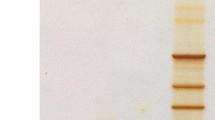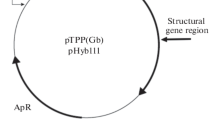Abstract
Plasmodium of myxomycete Physarum polycephalum produces cyclic nucleotide phosphodiesterase (PDE). The extracellular PDE is cAMP-specific and highly thermostable. This study demonstrates that the extracellular PDE of Ph. polycephalum is weakly inhibited by caffeine, isobutylmethylxantine and theophiline (type I mammalian PDE nonspecific inhibitors), dipyridamole (mammalian PDE5, PDE6, PDE8 and PDE10 inhibitors), and erythro-9-[3-(2-hydroxynonyl)]-adenine (mammalian PDE2 inhibitor). The enzyme does not require Mg2+ for the activity. The results show that the Ph. polycephalum extracellular PDE differs from class I PDEs, represented by mammalian PDE1-PDE11, and, most likely, belongs to a poorly investigated class II PDEs.
Similar content being viewed by others
Abbreviations
- PDE:
-
cyclic nucleotide phosphodiesterase
- EHNA:
-
erythro-9-[3-(2-hydroxynonyl)]-adenine, mammalian PDE2 inhibitor
References
Bender A.T., Beavo J. 2006. Cyclic nucleotide phosphodiesterases: Molecular regulation to clinical use. Pharmacol. Rev. 58(3), 488–519.
Stryer L. 1991. Visual excitation and recovery. J. Biol. Chem. 266(17), 10711–10714.
Wentzinger L., Seebeck T. 2006. Protozoal phosphodiesterases. In: Cyclic Nucleotide Phosphodiesterases in Health and Disease. Eds Francis S.H., Beavo J.A., Houslay M.D. CRC Press, p. 277–300.
Murray A.W., Spiszman M., Atkinson D.E. 1971. Adenosine 3′,5′-monophosphate phosphodiesterase in the growth medium of Physarum polycephalum. Science. 171(970), 496–498.
Kincaid R.L., Mansour T.E. 1979. Cyclic 3′,5′AMP phosphodiesterase in Physarum polycephalum. II. Kinetic properties. Biochim. Biophys. Acta. 588(3), 342–350.
Orlow S.J., Shapiro R.I., Franke J., Kessin R.H. 1981. The extracellular cyclic nucleotide phosphodiesterase of Dictyostelium discoideum. Purification and properties. J. Biol. Chem. 256(14), 7620–7627.
Nezvetskii A.R., Orlova T.G., Beilina S.I., Orlov N.Ya. 2006. Thermostabile extracellular cyclic nucleotide phosphodiesterase of the Physarum polycephalum plasmodium. Biofizika (Rus.). 51(5), 810–816.
Matveeva N.B., Morozov M.A., Nezvetskii A.R., Orlova T.G., Teplov V.A., Beilina S.I. 2010. The involvement of the extracellular cAMP-specific phosphodiesterase in the regulation of cellular activity of the Physarum polycephalum plasmodium. Biofizika (Rus.). 55(6), 1076–1082.
Rascon A., Soderling S.H., Schaefer J.B., Beavo J.A. 2002. Cloning and characterization of a cAMP-specific phosphodiesterase (TbPDE2B) from Trypanasoma brucei. Proc. Natl. Acad. Sci. USA. 99(7), 4714–4719.
Nikawa J., Sass P., Wigler M. 1987. Cloning and characterization of the low-affinity cyclic AMP phosphodiesterase gene of Saccharomyces cerevisiae. Mol. Cell. Biol. 7(10), 3629–3636.
Liebman P.A., Evanczuk A.T. 1982. Real time assay of rod disk membrane cGMP phosphodiesterase and its controller enzymes. Meth. Enzymol. 81, 532–542.
Orlov N.Ya., Kalinin E.V., Orlova T.G., Freidin A.A. 1988. Properties and content of cyclic nucleotide phosphodiesterase in photoreceptor outer segments of ground squirrel retina. Biochim. Biophys. Acta. 954(3), 325–335.
Bradford M. 1976. A rapid and sensitive method for the quantitation of microgram quantities of protein utilizing the principle of protein-dye binding. Anal. Biochem. 72, 248–254.
Wera S., Ma P., Thevelein J.M. 1997. Glucose exerts opposite effects on mRNA versus protein and activity levels of Pde1, the low-affinity cAMP phosphodiesterase from budding yeast, Saccharomyces cerevisiae. FEBS Lett. 420(2–3), 147–150.
Ma P., Wera S., van Dijck P., Thevelein J.M. 1999. The PDE1-encoded low-affinity phosphodiesterase in the yeast Saccharomyces cerevisiae has a specific function in controlling agonist-induced cAMP signaling. Mol. Biol. Cell. 10(1), 91–104.
Lacombe M.-L., Podgorski G.J., Franke J., Kessin R.H. 1986. Molecular cloning and developmental expression of the cyclic nucleotide phosphodiesterase gene of Dictyostelium discoideum. J. Biol. Chem. 261(36), 16811–16817.
Podgorski G.J. Franke J., Kessin R.H. 1986. Isolation of a cDNA encoding a portion of the cyclic nucleotide phosphodiesterase of Dictyostelium discoideum. J. Gen. Microbiol. 132(4), 1043–1050.
Hoyer L.L., Cieslinski L.B., McLaughlin M.M., Torphy T.J., Shatzman A.R., Livi G.P. 1994. A Candida albicans cyclic nucleotide phosphodiesterase: Cloning and expression in Saccharomyces cerevisiae and biochemical characterization of the recombinant enzyme. Microbiology. 140(7), 1533–1542.
Dunlap P.V., Callahan S.M. 1993. Characterization of a periplasmic 3′,5′-cyclic nucleotide phosphodiesterase gene, cpdP, from the marine symbiotic bacterium Vibrio fischeri. J. Bacteriol. 175(15), 4615–4624.
DeVoti J., Seydoux G., Beach D., McLeod M. 1991. Interaction between ran1 + protein kinase and cAMP dependent protein kinase as negative regulators of fission yeast meiosis. EMBO J. 10(12), 3759–3768.
Londesborough J. 1982. Activity of cyclic-AMP phosphodiesterase in permeabilised cells of Bakers’ yeast. Eur. J. Biochem. 126(3), 631–637.
Callahan S.M., Cornell N.W., Dunlap P.V. 1995. Purification and properties of periplasmic 3′,5′-cyclic nucleotide phosphodiesterase. A novel zinc-containing enzyme from marine symbiotic bacterium Vibrio fischery. J. Biol. Chem. 270(29), 17627–17632.
Bliokh Zh.L., Smolianinov V.V. 1977. Kinematics of the fibroblast spreading. II. Individual locomotor activity. Biofizika(Rus.). 22(4), 631–639.
Beilina S.I., Matveeva N.B., Priezzhev A.V., Romanovskiy Yu.M., Sukhorukov A.P., Teplov V.A. 1984. Plasmodium of the myxomycete Physarum polycephalum as an autowave self-organizing system. In: Self-organization Autowaves and Structures Far from Equilibrium. Springer-Verlag, p. 218–221.
Author information
Authors and Affiliations
Corresponding author
Additional information
Original Russian Text © A.R. Nezvetsky, T.G. Orlova, S.I. Beylina, N.Ya. Orlov, 2011, published in Biologicheskie Membrany, 2011, Vol. 28, No. 6, pp. 541–546.
The article wastranslatedby the authors.
Rights and permissions
About this article
Cite this article
Nezvetsky, A.R., Orlova, T.G., Beylina, S.I. et al. The effects of inhibitors and magnesium ions on the activity of the thermostable extracellular cAMP-Specific phosphodiesterase of Physarum polycephalum plasmodium. Biochem. Moscow Suppl. Ser. A 6, 100–104 (2012). https://doi.org/10.1134/S1990747811060109
Received:
Published:
Issue Date:
DOI: https://doi.org/10.1134/S1990747811060109




